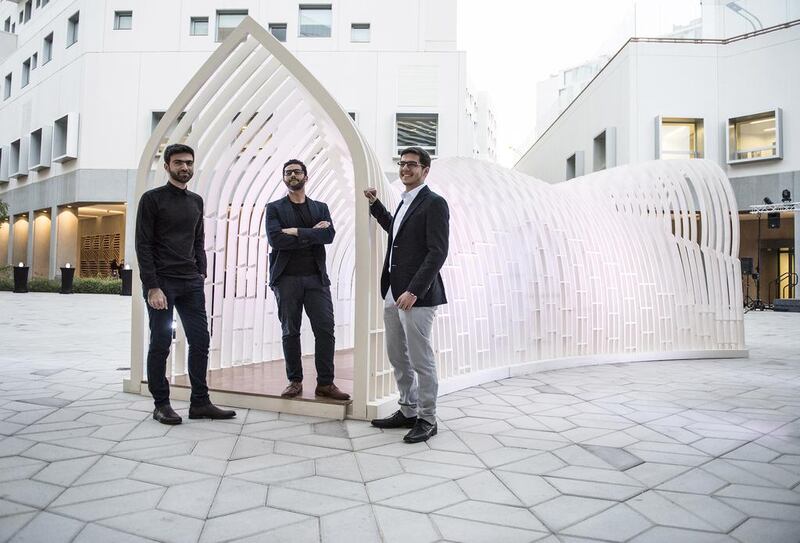A sculpture representing a physical and metaphorical pathway through the history of Islamic art and architecture was unveiled on April 4 in the plaza of New York University Abu Dhabi.
The Silk Road, an eight-metre-long artwork, is the winner of the fourth annual Christo and Jeanne-Claude Award. It is a tribute to the tradesmen of centuries past, upon whose work the foundations of the UAE were built – and is an innovative and contemporary piece of art.
The designers are Ghanem Mohamed Younes, from Egypt, and Jordanians Mohammad Abu Al Huda and Khalid Khairi Al Tamimi, who are architecture students at the American University of Sharjah. They refer to the work as an “architectural intervention”.
The trio were announced as the latest winners of the award – presented by NYUAD under the patronage of Sheikha Shamsa bint Hamdan Al Nahyan, and in partnership with the Abu Dhabi Music & Arts Foundation – in December, and have been working since then to produce the sculpture from their designs using their US$5,000 (Dh18,300) prize.
The piece is made up of 64 wooden layers, which vary in shape and size so as to link three archways from traditional Islamic architecture. The sculpture begins at one end with a pointed arch that originated in Isfahan during the Safavid era. Then the structure transforms into a more curved arch, from the Mameluke dynasty in Cairo, before ending in a rounded doorway from the Andalusian period.
The three archways are joined in a pathway, symbolising the Silk Road – the ancient trade route upon which all these empires were formed.
The designers were inspired to portray in one piece the importance of the development of art and architecture within these great civilisations and, more importantly, the effect they continue to have on the modern-day populations of the region. The piece also has symbolic value.
“We thought deeply about the metaphysical aspect of the project,” says Younes.
“These arches once welcomed the traders that passed through the region on the Silk Road.
“We are paying tribute to them and we are also interested in the spiritual journey taken by the originators of these arches, while at the same time creating a new and contemporary sculpture.”
Working under the mentorship of Professor Marcus Farr, the students tweaked their final design when they found out that they had been shortlisted and, as a result, impressed the judges to win the prize. In addition to the production grant, they received $10,000 (Dh36,730) to support their future careers.
“As architecture students, we don’t really get to build a lot, so for us this was an opportunity to exercise our capabilities,” says Al Tamimi. “Hands-on experience like this is invaluable – we have learnt much more about how things connect and also how people interact with the work.”
Launched in 2012, The Christo and Jeanne-Claude Award is open to full-time students in higher education in the UAE and those who have graduated in the past five years. The aim is to encourage the creation of large pieces of public art and, as such, inspire and encourage other students and aspiring artists.
The winner of the inaugural prize was Sheikha Maryam bint Sultan bin Zayed Al Nahyan. A student at Zayed University in Abu Dhabi, she designed a piece called Mirari using 30 closely clustered, light-reflective panels to evoke the effect of a mirage. They allow parts of the sculpture to be altered depending on location, environment, quality of light, day and season.
The second winner, NYUAD student Erin Meekhof, designed five sculptures based on the roots of ancient alphabets. She described her work, Abjad as "phylogenetic" trees which, once broken down, showed how the letters in seemingly disparate languages are linked.
Last year's winners were Salwa Al Khudairi and Nada Al Mulla, architecture students at the American University of Sharjah. Their sculpture, titled Keswa, was based on the design of the abaya. It was essentially a wall that curves in many directions, and was used as a kind of public shelter.
Metaphorically, it was also supposed to challenge certain assumptions that people may have about women who wear the abaya – showing creativity and individuality.
All of the winning entries were unveiled at NYU Abu Dhabi and have gone on to tour across the country.
As an additional part of this year's prize, the winners and the other four shortlisted entrants will travel to Lake Iseo, in northern Italy, where Christo has worked on a project called The Floating Piers.
For this, the artist has installed 70,000 square meters of shimmering yellow fabric, carried by a modular floating-dock system of 200,000 high-density polythene cubes, upon the lake.
It will last for only two weeks and is Christo’s first major installation in 10 years.
aseaman@thenational.ae





